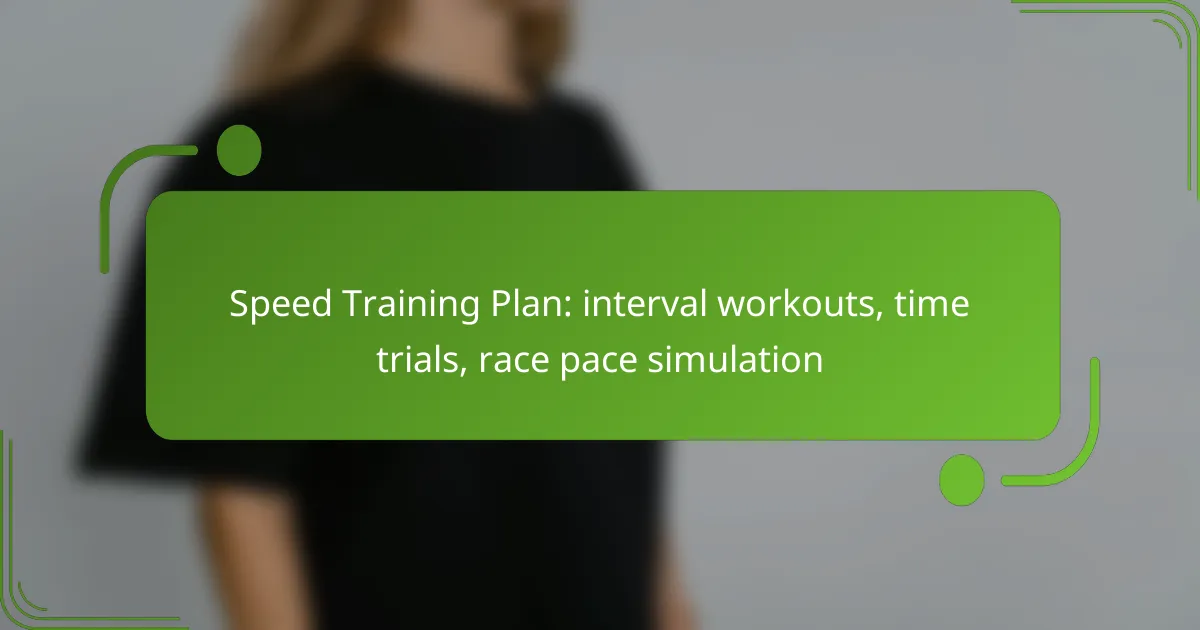Speed training is essential for athletes looking to enhance their performance, and it involves a combination of interval workouts, time trials, and race pace simulations. Interval workouts alternate high-intensity efforts with recovery, boosting speed and endurance. Time trials provide a controlled setting for athletes to test their limits and refine their pacing strategies, while race pace simulations prepare them for the specific demands of competition.

What are effective interval workouts for speed training?
Effective interval workouts for speed training include structured sessions that alternate between high-intensity efforts and recovery periods. These workouts enhance speed, endurance, and overall performance by pushing the body to adapt to faster paces.
400-meter repeats
400-meter repeats involve running a distance of 400 meters at a fast pace, followed by a recovery period. Typically, runners aim for a pace that is close to their race pace or slightly faster, with rest intervals of equal or slightly longer duration. For example, if you run a 400-meter repeat in 90 seconds, you might rest for 90 seconds to 2 minutes before the next repeat.
Incorporating 4 to 8 repeats into a workout can significantly improve speed and anaerobic capacity. It’s essential to maintain consistent pacing across all repeats to gauge improvement effectively.
Hill sprints
Hill sprints are short, intense bursts of speed performed on an incline. Running uphill increases resistance, which builds strength and power in the legs. A typical session might include 6 to 10 sprints of 20 to 30 seconds, with a walk or jog back down for recovery.
Focus on maintaining good form and driving your knees up during the sprint. Hill sprints can be particularly beneficial for developing explosive speed and improving running economy.
Fartlek sessions
Fartlek, which means “speed play” in Swedish, combines continuous running with varying speeds. During a fartlek session, you alternate between periods of fast running and slower recovery. For instance, you might sprint for 1 minute, then jog for 2 minutes, repeating this pattern for a total of 20 to 30 minutes.
This type of workout enhances both speed and endurance while allowing for flexibility in pacing. It’s a great way to simulate race conditions and can be done on any terrain.
Tabata intervals
Tabata intervals consist of 20 seconds of maximum effort followed by 10 seconds of rest, repeated for a total of 4 minutes. This high-intensity workout is effective for improving both aerobic and anaerobic fitness. You can perform Tabata intervals with various exercises, including running, cycling, or bodyweight movements.
Due to the intensity, it’s crucial to ensure proper warm-up and cool-down to prevent injury. Tabata can be a time-efficient way to boost speed and overall fitness.
Tempo runs
Tempo runs are sustained efforts at a challenging but manageable pace, typically around 80-90% of your maximum heart rate. These runs help improve your lactate threshold, allowing you to maintain faster paces for longer periods. A common structure is to run for 20 to 40 minutes at tempo pace after a warm-up.
Incorporating tempo runs into your training regimen can enhance speed endurance, making it easier to sustain race pace during competitions. Aim to include these runs once a week for optimal results.

How do time trials improve speed?
Time trials enhance speed by providing athletes with a controlled environment to gauge their performance and push their limits. These workouts simulate race conditions, allowing runners to practice pacing and develop the mental toughness needed for competition.
Benchmarking performance
Time trials serve as a benchmark for assessing current speed and fitness levels. By regularly conducting these trials, athletes can track improvements over time and identify areas needing attention. For instance, a runner might time themselves over a standard distance, such as 5 kilometers, to establish a performance baseline.
To effectively benchmark, aim to conduct time trials every few weeks, adjusting training based on results. This helps maintain motivation and provides clear goals for future workouts.
Building race-specific endurance
Time trials are crucial for developing race-specific endurance, as they mimic the physical and mental demands of actual races. By pushing through fatigue during these sessions, athletes can enhance their stamina and learn to maintain pace over longer distances. For example, a 10K time trial can help a runner prepare for a similar race by building the necessary endurance.
Incorporate time trials into your training plan at least once a month, gradually increasing distance or intensity to build endurance effectively. This approach helps ensure that you are prepared for the rigors of race day.
Identifying pacing strategies
Time trials allow athletes to experiment with different pacing strategies to find what works best for them. By trying out various speeds and techniques during these workouts, runners can learn how to distribute their energy effectively throughout a race. For instance, a runner might practice starting strong and maintaining a steady pace versus a more conservative start with a faster finish.
To identify effective pacing, consider using a GPS watch or a running app to monitor your speed during time trials. Analyze your performance data to determine which pacing strategy yields the best results, and apply these insights to your race-day approach.

What is race pace simulation?
Race pace simulation involves training at the speed you intend to maintain during an actual race. This method helps athletes prepare physically and mentally for the demands of competition by mimicking race conditions and strategies.
Replicating race conditions
To effectively replicate race conditions, athletes should choose a course that closely resembles the race route, including terrain and elevation changes. Incorporating similar weather conditions and time of day can further enhance the simulation experience.
During these workouts, aim to maintain your target race pace for a significant distance, ideally matching or exceeding the length of your upcoming race. This practice helps the body adapt to the specific demands of racing.
Practicing nutrition strategies
Race pace simulation is an ideal time to test nutrition strategies that will be used on race day. This includes experimenting with hydration, energy gels, or snacks to determine what works best for your body during prolonged efforts.
Consider timing your nutrition intake to align with your race plan. For example, if you plan to consume a gel every 30 minutes during a marathon, practice this routine during your simulation workouts to see how your body responds.
Enhancing mental toughness
Training at race pace can significantly boost mental toughness by pushing athletes to confront discomfort and fatigue. Embrace the challenge of maintaining pace even when it becomes difficult, as this mirrors the mental strain experienced during actual races.
Incorporate visualization techniques during these workouts, imagining yourself successfully navigating the race. This mental preparation can help build confidence and resilience, making you more prepared for race day challenges.

What are the prerequisites for a speed training plan?
A speed training plan requires a solid foundation of fitness, clear goals, and the right equipment. These prerequisites ensure that the training is effective and safe, allowing athletes to maximize their performance gains.
Baseline fitness assessment
Before starting a speed training plan, it’s crucial to evaluate your current fitness level. This assessment can include tests for endurance, strength, and flexibility, helping to identify areas that need improvement. Common methods include time trials, where you measure your performance over a set distance, and interval workouts to gauge your speed.
Consider consulting a coach or using fitness apps that can provide structured assessments. Regular evaluations every few weeks can help track progress and adjust your training accordingly.
Goal setting
Setting specific, measurable goals is essential for a successful speed training plan. Goals should be realistic and time-bound, such as improving your 5K time by a certain percentage within a few months. This clarity helps maintain motivation and focus during training.
Break down larger goals into smaller milestones, such as achieving a specific pace during interval workouts. This approach allows for incremental progress and keeps you engaged throughout the training process.
Equipment requirements
Having the right equipment is vital for effective speed training. Essential items include a good pair of running shoes suited to your foot type and running style, as well as comfortable workout clothing. A stopwatch or a GPS watch can help track your intervals and overall pace during workouts.
Consider using additional tools like resistance bands for strength training or a heart rate monitor to ensure you’re training within your target zones. Investing in quality gear can enhance your training experience and reduce the risk of injury.

How to choose the right speed training plan?
Choosing the right speed training plan involves assessing your current fitness level, identifying specific goals, and considering the time you can commit. A well-tailored plan will help you improve your speed effectively while fitting into your lifestyle.
Assessing current fitness level
Start by evaluating your current fitness level through recent performance metrics, such as race times or personal bests in workouts. Consider factors like your endurance, strength, and speed to determine a baseline. This assessment will guide you in selecting a plan that aligns with your capabilities.
Common methods to assess fitness include time trials, interval workouts, or even fitness tests like the Cooper test. These benchmarks will help identify areas for improvement and set realistic expectations for your speed training journey.
Identifying specific goals
Clearly defined goals are essential for a successful speed training plan. Whether you aim to improve your 5K time, enhance your sprinting speed, or prepare for a specific race, knowing your objectives will shape your training approach. Write down your goals to maintain focus and motivation throughout your training.
Consider using the SMART criteria—Specific, Measurable, Achievable, Relevant, and Time-bound—to refine your goals. For example, instead of saying “I want to run faster,” specify “I want to reduce my 10K time by two minutes in three months.” This clarity will help you track progress effectively.
Considering time commitment
Your available time for training plays a crucial role in selecting a speed training plan. Assess your weekly schedule to determine how many days and hours you can realistically dedicate to workouts. A plan that requires excessive time may lead to burnout or inconsistency.
Typically, speed training plans range from three to six days per week, depending on your goals and fitness level. Prioritize quality over quantity; shorter, focused workouts can be more effective than longer, less structured sessions. Ensure your plan includes rest days to allow for recovery and adaptation.

What are common mistakes in speed training?
Common mistakes in speed training include neglecting recovery, overtraining, and improper pacing. These errors can hinder performance improvements and increase the risk of injury.
Neglecting recovery
Neglecting recovery is a frequent mistake in speed training that can lead to burnout and decreased performance. Recovery allows the body to repair and adapt to the stress of intense workouts, making it essential for long-term progress.
Incorporating rest days and active recovery sessions into your training plan is crucial. Aim for at least one full rest day per week, and consider low-intensity activities like walking or swimming on recovery days to promote blood flow without overexertion.
Listen to your body and adjust your training intensity based on how you feel. If you experience persistent fatigue or soreness, it may be a sign to take additional rest or modify your workout schedule to prevent injuries.
